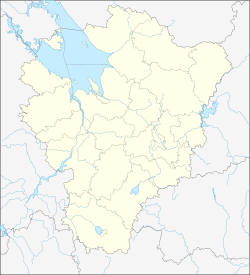Rostov
| city
Rostov
Ростов
|
||||||||||||||||||||||||||||||||||||||||
|
||||||||||||||||||||||||||||||||||||||||
|
||||||||||||||||||||||||||||||||||||||||
| List of cities in Russia | ||||||||||||||||||||||||||||||||||||||||
Rostov ( Russian Ростов ) is a Russian town in the Yaroslavl Oblast with 31 792 inhabitants (as of October 14, 2010), approximately 225 km north-east of Moscow on the railway line Moscow-Yaroslavl , who also trains the since the 1930 Trans-Siberian Railway sail becomes. Rostov is located on Lake Nero and is therefore also called Rostow Jaroslawski or Rostow am Nero , in contrast to Rostov-on-Don . It belongs to the Golden Ring of Russia and is an important tourist center. Up to the 18th century the city of Rostov was called Veliky (in today's Russian spelling Росто́в Вели́кий ), which means something like "Greater Rostov".
history
Rostov is one of the oldest Russian cities. In the Nestor Chronicle Rostov is mentioned for the first time for the year 862nd Around 988 it became the seat of an independent sub-principality under Yaroslav the Wise . In 991 one of the first eparchies (diocese) of the Kievan Rus was built here. Prince Boris was murdered in 1015 . He became the first saint of the Russian Orthodox Church .
1113 Rostov was again the seat of a principality under Yuri Dolgoruki . In 1125 he moved the prince's seat to Suzdal in order to evade the influence of the city's boyars . From 1207 to 1219 the city was once again the center of a principality under Konstantin Vsevolodowitsch . At that time it was a densely populated city with a royal court, boyar seats and vigilante groups. Merchants and artisans made up the majority of the population. In 1238 the city was destroyed in the course of the Mongol invasion.
1474 acquired Grand Duke Ivan III. Rostov for the Grand Duchy of Moscow and Rostov lost its political relevance. In cultural, architectural and religious terms, however, its importance grew in the following centuries. Annual fairs since the 18th century and the establishment of textile manufacturers in the 19th century determined the economic development of the city.
Population development
| year | Residents |
|---|---|
| 1897 | 13,715 |
| 1939 | 29,808 |
| 1959 | 29,230 |
| 1970 | 30,815 |
| 1979 | 31,538 |
| 1989 | 35,707 |
| 2002 | 34,141 |
| 2010 | 31,792 |
Note: census data
Attractions
The city has a variety of architectural attractions, including the Kremlin with the Uspensky Cathedral and many other churches, as well as the Prince's Palace, an outstanding example of secular architecture. The world-famous Big Bells in the Kremlin, which Hector Berlioz visited in 1869, deserves special attention in order to experience with his own ears the various melodies of the bell for which the Rostov bell ringer were world famous.
Furthermore, the arcades in the old town and the Redeemer Jacob Monastery in front of the city should be emphasized, which has old Russian and very splendid classical architecture. There are also several monasteries around the city such as the Abraham Monastery and the famous Boris and Gleb Monastery .
economy
The main branches of industry are plant construction, textile industry, food industry, handicrafts and agriculture.
sons and daughters of the town

- Yaroslav the Wise (979 / 986-1054), first prince of Rostov (around 988-around 1010)
- Boris (around 986-1015), Prince von Roatow (around 1010-1015), first saint of the Russian Orthodox Church
- Sergius von Radonezh (around 1319–1392), venerated saint in Russia and founder of the Trinity Monastery in Sergiev Posad
- Dimitri Tuptalo (1651–1709), Metropolitan of Rostov
- Alexander Titow (1878–1961), chemist and entrepreneur
- Vera Weizmann (1881–1966), wife of Chaim Weizmann , doctor and Zionist activist
- Michail Wolozkoi (1893–1944), geneticist
- Daniel Guilet (1899–1990), classical violinist
- Andrei Jepifanow (1900–1985), graphic artist
- Juri Bilibin (1901–1952), geologist
- Nina Gurina (1909–1990), prehistoric
- Igor Gruschko (1912–1941), mathematician
- Wiktor Dombrowski (1913–1972), astronomer and astrophysicist
- Nikolai Alexejew (1914–1980), Soviet military, Marshal of the Intelligence Force
- Nikolai Rykunin (1915–2009), actor
- Lew Naumow (1925-2005), pianist
- Juri Bubnow (* 1934), chemist
- Alexander Melnik (* 1952), historian
- Alexander Frautschi (1954–2008), classical guitarist
- Irina Lebedewa (* 1956), art scholar
- Evgeny Ring (* 1987), jazz musician
- Olena Krywyzka (* 1987), Ukrainian sword fencer
See also
- Eparchy of Yaroslavl and Rostov
- Rostower Finift (enamel work from Rostov)
Web links
- Official website of the Raion Administration (Russian)
- Rostov on mojgorod.ru (Russian)
- Rostov Kremlin Museum with information about the city and its history (Russian)
- Rostov Kremlin Museum at museum.ru (Russian)
- Rostov (Veliky) and the cities of the Golden Ring
Individual evidence
- ↑ a b Itogi Vserossijskoj perepisi naselenija 2010 goda. Tom 1. Čislennostʹ i razmeščenie naselenija (Results of the All-Russian Census 2010. Volume 1. Number and distribution of the population). Tables 5 , pp. 12-209; 11 , pp. 312–979 (download from the website of the Federal Service for State Statistics of the Russian Federation)







